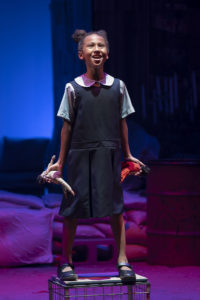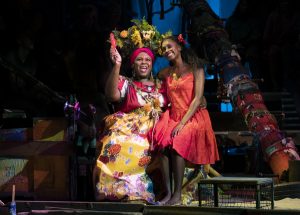
Broadway in Chicago brings to the Cadillac Palace stage a story of fate, religion, and indigenous culture that charms and delights. Directed by Michael Arden and featuring native dance, upbeat music, inspired costumes (designed by Clint Ramos), and true-to-life set design (by Dane Laffrey), “Once on This Island” is a musical that takes place in the French West Indies, on an island known as the Jewel of the Antilles. This touring production of Lynn Ahrens’ book and lyrics and Stephen Flaherty’s music tells an important tale about the magic of love, the mystical powers of healing, and the force of destiny—and the myth, history, and heritage of an exotic island people.
This is, in part, a coming-of-age story. Long ago, a loving couple Mama Euralie and Tonton Julian (played by Danielle Lee Greaves and Phillip Boykin) takes in a young girl, saved by the gods in a huge rainstorm that devastates her home. Ti Moune (Courtnee Carter), a name that means “orphan”, eventually grows up and becomes a lovely young woman. With her beautiful voice, she sings about her wants, desires, and fate. The gods intervene. Amidst a powerful rainstorm, there is a car crash. Daniel Beauxhomme (Tyler Hardwick), a handsome young man, lies injured and unconscious. Ti Moune is the first to find him and nurses him back to health. In the process, she falls in love. Once Daniel recovers and returns home, Ti Moune cannot contain her deep and abiding love for him. So after some initial resistance from her adoptive parents, Ti Moune travels a great distance on her own to reunite herself with this stranger, not knowing that he has already been pledged to Andrea Devereaux (Briana Brooks). On top of it all, Daniel has forgotten all about Ti Moune and the role she has played in his healing. She is heartbroken to learn that he cares nothing for her at all.
Although the Antilles were colonized by France in the 1600s, the story of Daniel and the Beauxhomme family is not an exact parallel. When Napoleon invaded the island of Daniel’s ancestors, French men played “fast and loose” with indigenous women, such that a two-caste system emerged. The privileged class was that of light skin, who chose to emulate whites from Europe and look down upon their dark-skinned brethren. In “Once on This Island”, color discrimination between the two castes is related to the color of copper; if one’s complexion is lighter than this, then the person is accepted by the upper crust; if darker, then they are not. Daniel’s haughtiness has in large part to do with buying into the ideology behind skin color differences. Daniel is light-skinned, or privileged in the caste hierarchy, whereas Ti Moune is dark-skinned and is viewed with disdain among Daniel’s family as being wild, inferior, and of questionable morality. (After all, she doesn’t want to wear shoes!) Additionally, Daniel is part of a culture that emulates the French and has no use for native customs, dances, and traditions except as a curiosity.
The dark-skinned natives, however, have the powerful ability to heal people in ways that Western medicine never cared to learn about or did not respect; they all have a sincere fear and admiration for the gods who can both heal and destroy. And so the gods fight among themselves as to how to handle this situation on earth. After all, voodoo can heal… or kill. Rather than kill Daniel due to his failure to return her affections or kill herself in grief, Ti Moune instead, with the help of the gods, memorializes herself by being turned into a sacred and symbolic tree for all to gaze at, as a remembrance of her love and her ability to heal.
Myths about the transformation of human beings into trees (and vice versa) is not without precedent. In Greek mythology, Daphne sacrifices herself and is turned into a tree by the tree river god, Peneus. In Old Norse mythology, the first people were named Ask and Embla; they were originally trees, corresponding to the modern tree names of Ash and Elm. In India, one aspect of Hindu belief is the worship of the Tulsi tree, considered the holiest of all plants, the threshold between heaven and earth, with the creator-god Brahma residing in its branches. In the current story, a peasant girl of a subsequent generation climbs the branches of the sacred tree, thus honoring Ti Moune and the mysteries of Voodoo and Voodooism.
The dance numbers are beautifully choreographed, and Camille Brown and Rickey Tripp deserve praise for their festivity. Special shoutouts must be made to all the people associated with the music: music director and conductor (and instrument master) Steven Cuevas, associate conductor Ilana M. Atkins, John Miller, Alvin Hough, Jr., and musicians Mariana Ramirez-Alvarado, Sherisse Rogers, Oscar Bautista, Randy Cohen, and especially Cassondra James who performs as Erzulie, the goddess of love, and plays the flute in that role.
 Again, the costuming was spectacular! Some of the more creative favorites are that of Agwe (Jahmaul Bakare) representing the rain god, the mish-mash mango/football jersey dress worn by Asaka (Kyle Ramar Freeman) representing the god of earth, and the outfit worn by the demon of death Papa Ge (Tamyra Gray).
Again, the costuming was spectacular! Some of the more creative favorites are that of Agwe (Jahmaul Bakare) representing the rain god, the mish-mash mango/football jersey dress worn by Asaka (Kyle Ramar Freeman) representing the god of earth, and the outfit worn by the demon of death Papa Ge (Tamyra Gray).
There was one, albeit minor, flaw in the performance. As a result of the huge opening number, the plot gets off to a slow start. This has to do with the fact that the operetta has such a large cast with so many different storytellers and so many different characters that it is initially hard to sort them all out. More importantly, on the night I attended, there was a sound issue, such that there was too much dissonance during the large chorus/company numbers when a certain volume was exceeded—so it was hard to hear the words in some of the songs. This was remedied, however, maybe 45-50 minutes into the show, making the rest much more enjoyable.
Cloaked in folklore and mysticism, “Once on This Island” shows how a native people defines itself and carries its culture and oral tradition on to the next generation. We, the audience, become part of that modern retelling, which is why some members are seated on stage; they too are the intended recipients of this myth.
To heal others properly, you must first love. To love, you must feel. To feel, you must be in touch with yourself and with nature. This is not the Hippocrates model of “Do no harm” in practicing medicine but, rather, is based on the intent to sincerely care about the health and well-being of the patient as a form of unrequited love. In order for treatment to be successful, one must ground oneself and be rooted to the earth—and to the will of the gods. Such is the meaning behind Ti Mouna’s sacred tree of healing. Hence the operetta captures the essence of what Henry David Thoreau once wrote in Walden, “Shall I not have intelligence with the earth? Am I not partly leaves and vegetable mould myself?”
Broadway in Chicago’s production of “Once on This Island: The Musical” is playing at the Cadillac Palace Theatre, 151 W. Randolph Street, Chicago, through February 2, 2020.
Tickets range between $21.50 and $96.00. Prices may fluctuate or may be higher, based on demand and date, and may be purchased at the box office or via Ticketmaster.com.
Performance schedule:
Tuesdays, Thursdays, Fridays – 7:30 p.m.
Wednesdays – 2:00 p.m. and 7:30 p.m.
Saturdays – 2:00 p.m. and 8:00 p.m.
Sundays – 2:00 p.m. with an additional performance on Sunday, January 26th at 7:30 p.m.
For more information, visit www.BroadwayInChicago.com
To see what others are saying, visit www.theatreinchicago.com, go to Review Round-Up and click at
Once on This Island”.







More Stories
“Dummy in Diaspora”
“The Magic School Bus: Lost in the Solar System”
“February House” reviewed by Julia W. Rath